Open in 2024: Mar 4-5, 7-8, April 15-16, 18-19, May 6-12, June 10-16, July 8-14, Aug 17-25, Sept 2-6, 9-13, Oct 7-8, 10-11, Nov 4-5, 7-8, Dec 2-3, 5-6, 11am-3pm
Fee: adult €8, OAP/student/child €5, National Heritage Week free
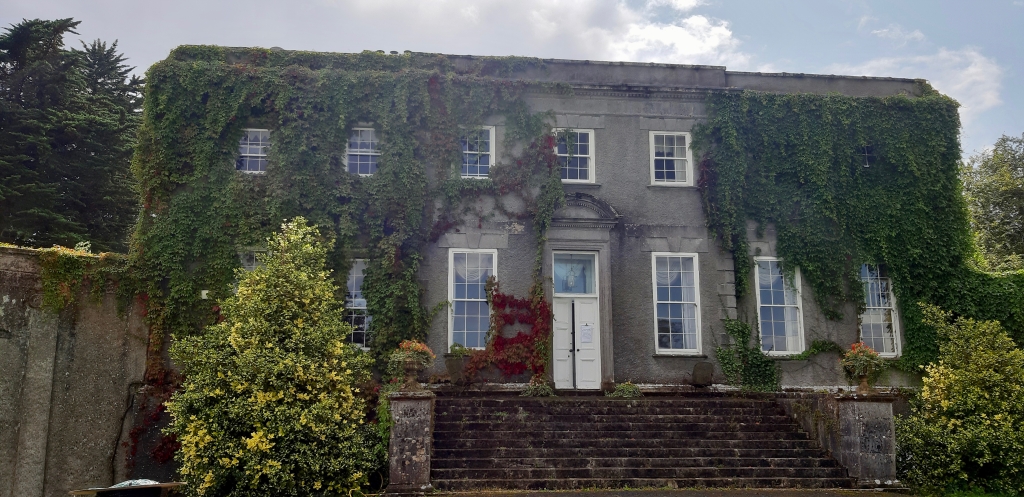

donation
Help me to pay the entrance fee to one of the houses on this website. This site is created purely out of love for the subject and I receive no payment so any donation is appreciated!
€10.00
We visited Swainstown House on Monday 19th August 2019, during Heritage Week. Stephen took the entire week off work. It was an opportunity to visit the section 482 Houses, as all are open that week!
Swainstown is a house built in 1750 of two storeys with a seven bay centre block attached to two wings by curved sweeps with Ionic pilasters, in the Palladian style. It is not known who the architect was, but the Irish Aesthete suggests that Richard Castle may have had a hand in designing it. The wings originally housed the servants’ quarters and the stables. The centre block has a breakfront of three bays, and an arched pediment over the front door. The Irish Aesthete comments on the limestone window lintels, which he says show a “whimsical caprice,”along with the exaggeratedly tall and narrow doorcase [1]. I think the caprice of the lintels must be that the ones on the first storey resemble the ones on the lower storey upside-down. The front door is approached by a broad flight of stone steps.

I always like when the house is still owned by descendants, and Swainstown is one such property. It was built for Nathaniel Preston, an ancestor of the current owner, John “Punch” Preston. Caroline, the listed contact, is his wife. I contacted Caroline in advance, and she told me that Anne, who stood in as tour guide while Caroline was away, would meet us at the door at 2pm. Indeed she was there as promised, and gave us a tour of the house. “Punch” farms the land, and his son Arthur now also farms and has started a chemical-free produce business, Swainstown Farm. [2] We came across Punch in the yard in a tractor when we explored the grounds after the house tour. Caroline and her husband live in the main house and her son in what was formerly the servants’ area.
Nathaniel was given the lands of Swainstown by his father, John (1611 – 1686). According to a website about the history of Navan, John Preston was a grandson of Jenico Preston, 3rd Viscount Gormanston [3]. After much digging, I have found that he was in fact the great grandson. [4]
Stephen found this reference to John Preston in his ancestor Earl George Macartney’s papers! Stephen’s six-times great aunt, Elizabeth Winder, married George Macartney (1695-1779). Earl Macartney recorded genealogical data of some prominent families in Ireland. He writes that John Preston, Alderman of Dublin, was son of Hugh Preston of Bolton in Lancashire. The Prestons originally came from Lancashire.
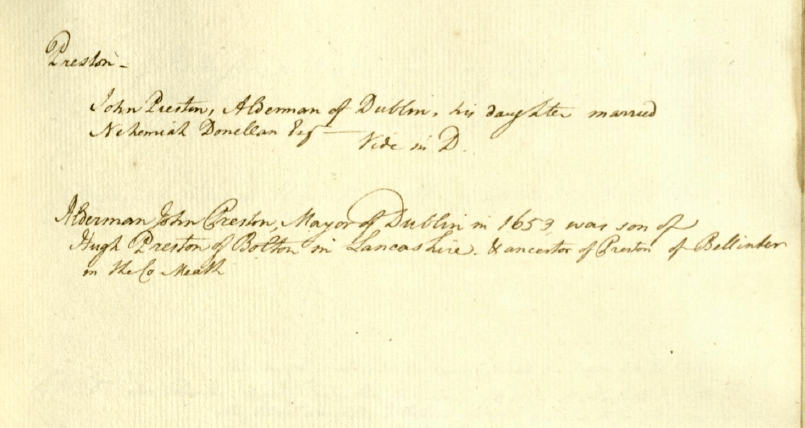
John’s grandfather Martin, although being the son of Viscount Gormanston, was the youngest son so did not inherit a fortune. John Preston therefore had to build up his own fortune, and so he went into business as a merchant in Dublin. There are conflicting accounts of how John acquired land beyond Dublin. According to a website on Bellinter House, a house built on lands which John purchased, he bought up property after Oliver Cromwell confiscated lands of those who had fought against his Parliamentary armies. The land of Swainstown previously belonged to the Nangle family, an Anglo-Norman family who held the title Baron of Navan. They were Catholic and fought in the army against Cromwell, so were outlawed and their lands confiscated. Confiscated lands were parcelled out to Cromwell’s soldiers as a means of payment for their services. Many of these soldiers sold the land if they had no interest in farming or of living in Ireland. John Preston took advantage of this to establish his family country seats, acquiring 7,859 acres of land in County Meath and Queens County (now Laois) in 1666.
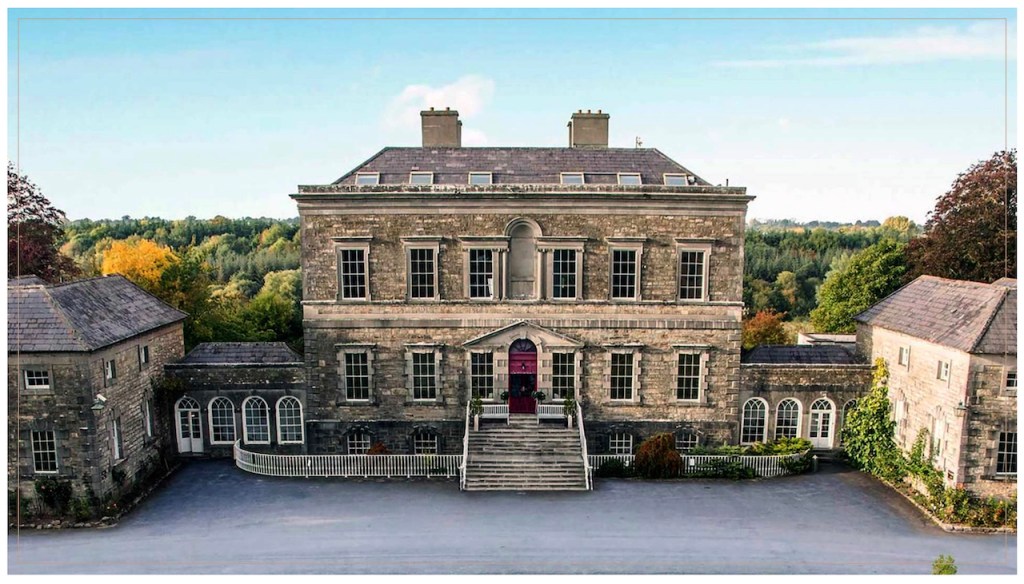
The website also tells us of a clever ploy utilised by Preston to protect his land from being returned to its original owners. He placed 1,737 acres in trust for the keeping of two schools, one in Navan and one in Ballyroan in Laois. The website for Bellinter House tells us that this placing of land in trust for schools was probably done in order to make it more difficult for the original owners to seek return of their property, since charitable institutions were now involved! [5]
There is a note, however, on the Navan History website, that “It is reputed that John Preston married a daughter of Baron Nangle of Navan and that this was how he came into the lands in Co. Meath. However, this cannot be confirmed.” I think instead that John Preston’s mother was a Nangle, Mary Margaret, grand-daughter of Thomas Nangle, the 17th Baron of Navan. He may therefore have come into some of his land through his mother. Using the website ancestry.co.uk, I believe Mary Margaret’s father was Jocelyn Nangle, and that he fought in the rebellion of 1641. He probably had land confiscated, but as his family supported Charles II, much of their land was restored to them. A study of the history of the Prestons and the families with which they intermarried would certainly give a fascinating picture of land ownership in the tumultuous and violent times of the Civil War between the armies of Charles I and Oliver Cromwell and struggles for land ownership and restoration under King Charles II.
As well as being a merchant, John Preston was also involved in government and administration. He was appointed as Clerk of the Tholsel (the seat of Dublin city council) in 1650. The Tholsel building stood on the site that is now Dublin’s City Hall. Two days after being appointed as Clerk he was elected as Alderman in the Corporation of Dublin. A few years later he was elected to be Lord Mayor of Dublin in 1653.
John was elected as a Member of Parliament for Navan in 1661. His land ownership was confirmed under the Act of Settlement after the restoration of the monarchy to Charles II. He also owned property in Dublin and he donated the site for the “Hospital and Free School of King Charles II” or more informally called Blue Coat School, a school which was founded in 1669, which is now the home of the Law Society of Ireland. The building of the school became quite controversial as it became a tool for showing off one’s wealth and generosity, and subsequently the building, built by Thomas Ivory, was far grander than that required for a school.

John married, first, Mary Morris of Lancashire, and had three children with her: Mary, Phineas and Samuel. She died in 1654 and he married a second time, to Katherine Ashburnham, widow of a John Sherlock. He married a third time, to Anne Tighe, who was the daughter of Richard Tighe who had also served as an Alderman and then Mayor of Dublin, and had two more sons, John and Nathaniel [6]. He distributed the land he had acquired to his four sons: Phineas, Samuel, John and Nathaniel.
Ardsallagh, which had formerly been a property of the Nangles, went to his son Phineas, although Phineas died before his father so it went to Phineas’s son, John. By the way, it is exciting to note as a former philosophy student that Ardsallagh passed down to the English philosopher Bertrand Russell! According to the Bellinter website, Ardsallagh was passed down through the family and was left by the heirless George James Ludlow, Third Earl of Ludlow, to the Duke of Bedford, as they shared the same political views. This Duke willed the property to his brother Lord John Russell, who became Prime Minister of England. From him, the estate passed down to Bertrand Russell!

John’s second son Samuel inherited land in County Laois (around Ballyroan and Emo, although Emo Court was not built for another 100 years, by Joshua Dawson in 1790). He married Mary Sandford, daughter of Theophilus Sandford of Moyglare, County Meath.
The third son, John, inherited land in Balsoon, County Meath, and built Bellinter House, near to Swainstown, and Nathaniel, the fourth son, inherited Swainstown.
Nathaniel was born around 1678. In 1713 he followed in the footsteps of his father and was elected M.P. for Navan, and he held this position until 1760, the year he died. He married Anne Dawson in 1719, sister of Joshua Dawson (1660-1725) who developed Dawson Street, Dublin (as well as Anne Street – probably named for his wife Anne [nee Carr] and Grafton Street, and also organised construction of the Mansion House in Dublin in 1710 which was purchased in 1715 to be the official residence of the Mayor of Dublin). [The Navan history website says Nathaniel’s wife was a niece of Joshua Dawson but according to the Peerage website, she was a sister.] Nathaniel’s daughter Anne married Joseph Leeson, 1st Earl of Milltown – another prominent Dublin street name! He had Russborough House in County Wicklow built, so Nathaniel’s daughter married very well!
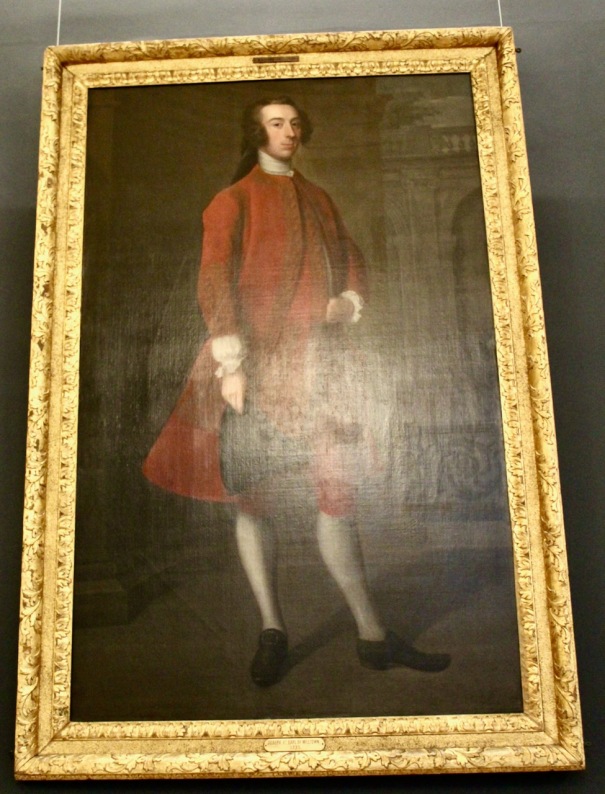
The Navan history website quotes a lovely description of Nathaniel Preston, written by Mrs. Delaney:
“an old prim beau, as affected as a fine lady: but an honest man, obstinate in his opinions, but the pink of civility in his own house, which is as neat as a cabinet, and kept with an exactness which is really rather troublesome.‟ [7]

Nathaniel’s second son, also named Nathaniel, born in 1723, became a Protestant clergyman. His older brother died, and he inherited Swainstown. Reverend Nathaniel died in 1796 and left Swainstown in turn to his son, also named Nathaniel (the third, 1752-1812) – the name was passed on through the family and continues today. [8]
Reverend Nathaniel (1724-1796) married first Alice Dillon, daughter of John of Lismullen. They had several children. After she died, he married again, this time to Mary Hamilton, granddaughter of Gustavus Hamilton, 1st Viscount Boyne, and they didn’t have any more children.
The Preston ancestors are interred in a vault under Kilmessan Church, next to Swainstown.
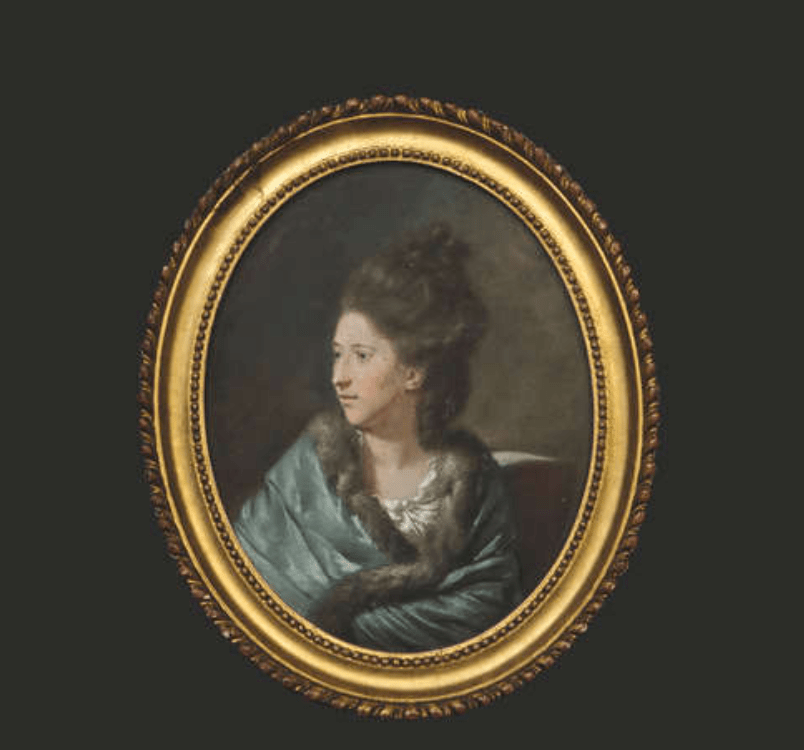
Swainstown is built on land near an old abbey – Anne showed us the remains of the abbey on the property.
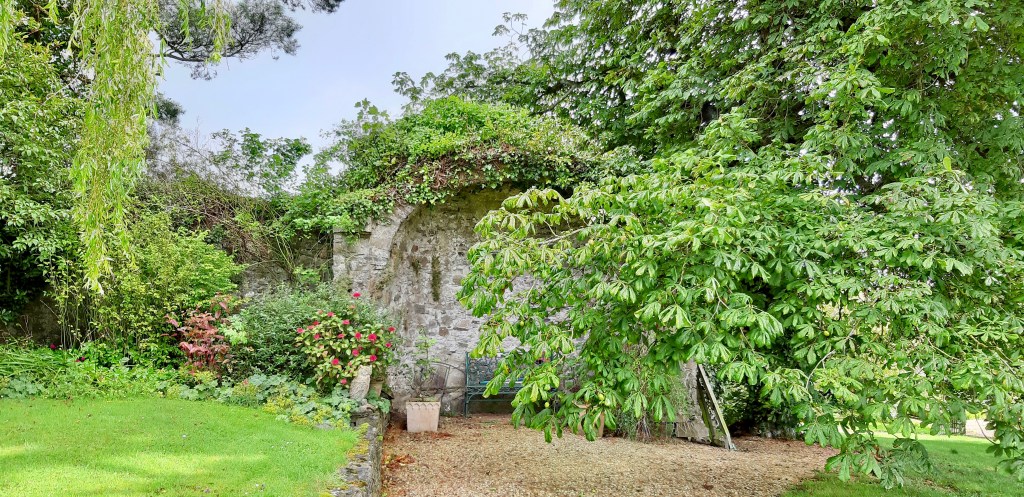
In the house we were shown one of the few still-in-use dumb waiters in Ireland, and I was allowed to take a photograph:
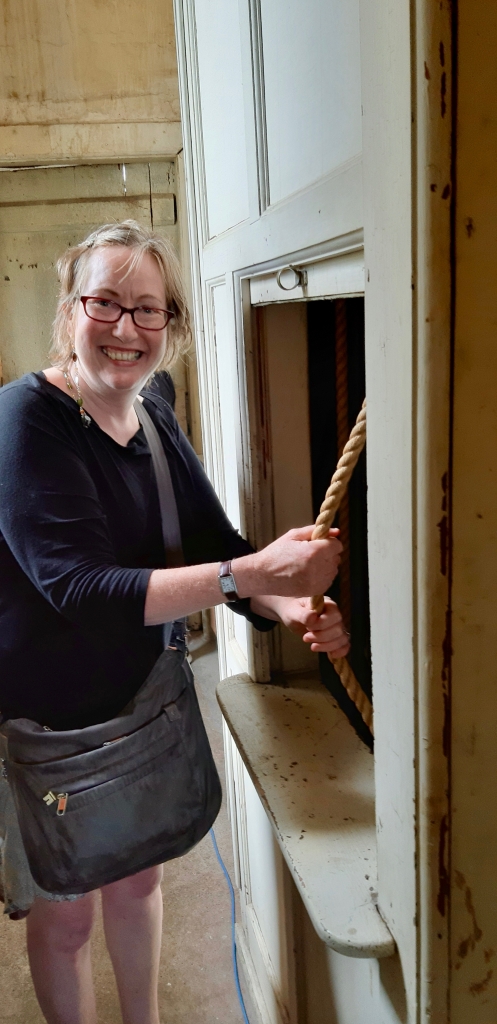
We were also shown Caroline Preston’s book, This Tumult, when we told Anne that we honed our interest in history first by researching our family genealogies. Caroline too researched her family history and what she found was so interesting that she wrote a book about what she found!
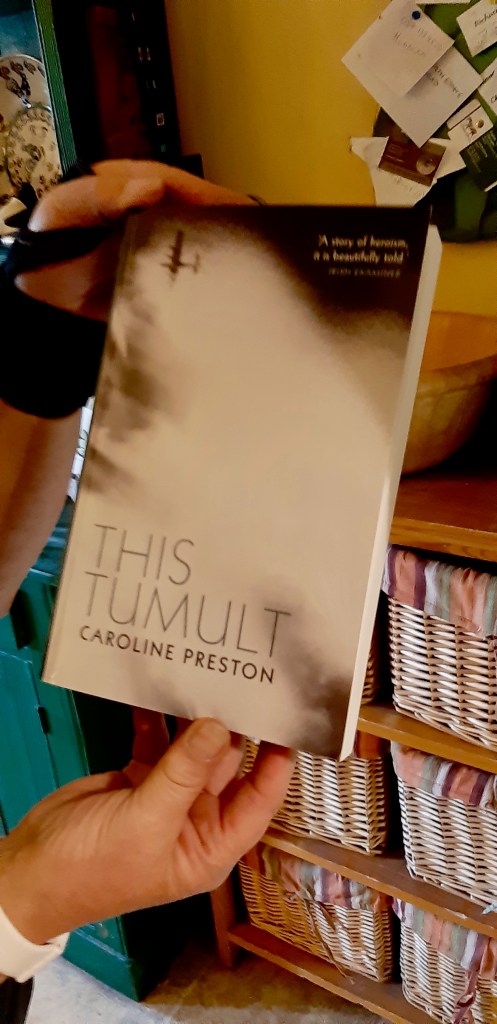
It was raining on and off, so we didn’t get to explore the grounds as much as we would have liked, but Anne did show us around close to the house and I took some photographs. I envied them the pool they had installed a few years ago! Also the beautiful grounds.
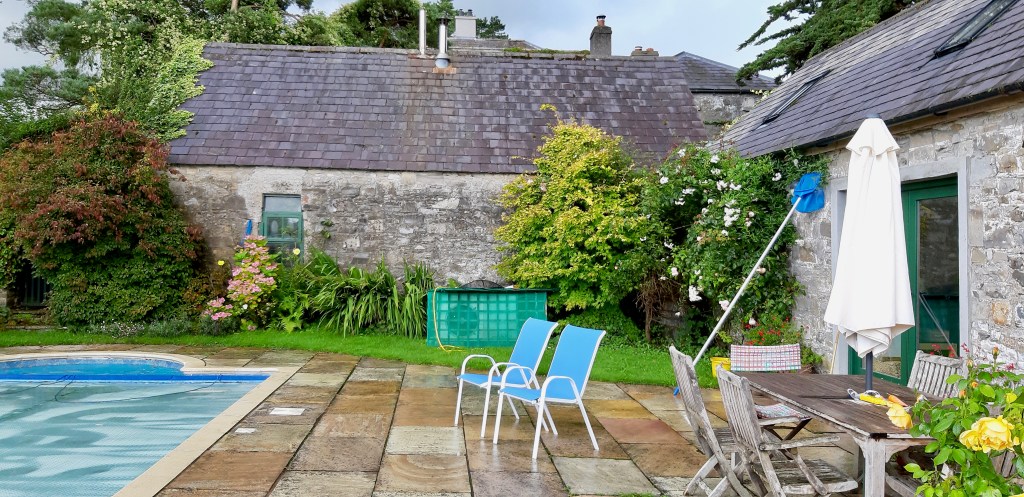
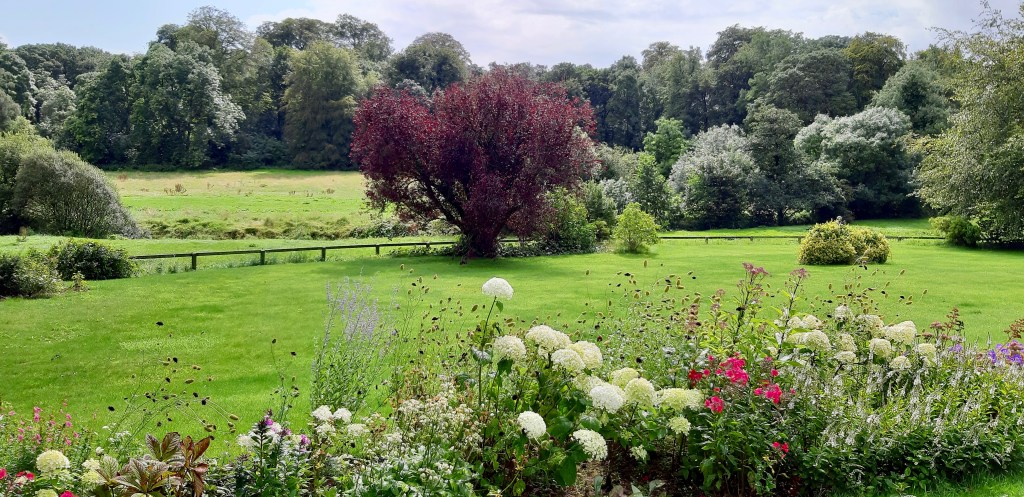

I love the bridge which we could see from the back of the house! Arthur is developing a path through the woods, that will lead to the ice house, which is being restored. I look forward to returning for a walk in the woods!
[1] https://theirishaesthete.com/tag/swainstown/
[2] https://www.swainstownfarm.com/pages/about-us
[3] http://www.navanhistory.ie/index.php?page=preston
[4] I worked this out using family trees on www.ancestry.co.uk
John Preston’s father was Hugh Preston. Hugh Preston was the son of Martin Preston, who was a son of Jenico Preston, 3rd Viscount Gormanston.
[5] https://www.bellinterhouse.com/history.html
[6] https://en.wikipedia.org/wiki/John_Preston_(alderman)
Anne Tighe’s brother was an ancestor of the Tighes of Altidore, another section 482 property.
[7] http://www.navanhistory.ie/index.php?page=preston
[8] The genealogy is complicated, due to the repetition of names passed from father to son. Note that the Navan history website states that Reverend Nathaniel Preston married Alice Dillon, in 1751, as does http://www.bomford.net/IrishBomfords/Chapters/Chapter18/Preston%20in%20Burke%201912.htm
According to the peerage website http://www.thepeerage.com/p14786.htm#i147860, the Reverend Nathaniel Preston (second Nathaniel) married Mary Hamilton. However, as the third Nathaniel was born in 1752, Mary Hamilton must have been Reverend Nathaniel’s second wife, as he married Mary Hamilton in 1763.
The Navan history website also claims that this Reverend Nathaniel served on the Grand Jury of Meath in 1801 and 1811, and that his wife Alice’s father John Dillon, his son Charles, and Nathaniel Preston formed a company to exploit a vein of copper ore on the Walterstown lands of Nathaniel Preston. As the second Nathaniel died in 1796, I wonder if it was the third Nathaniel Preston who served on the Grand Jury and who formed the mining company i.e. not the Reverend but the Reverend’s son.
Nathaniel (the third, b. 1752 died 1812) also had a son named Nathaniel (the fourth, b. 1813), who inherited and lived in Swainstown. The fourth Nathaniel is said on the peerage website to have died in 1840, but elsewhere is said to have had his son Nathaniel (the fifth), ie. Nathaniel Francis Preston, in 1843, so the death in 1840 does not make sense. The Bomford website says he died in 1853, which makes more sense. The fourth Nathaniel (b. 1813) married Margaret Winter in 1839. When his father died he inherited Swainstown, which at the time consisted of about 320 acres.
Nathaniel Francis Preston married Augusta Florence Caulfield of Bloomfield, Mullingar, in 1865. According to the Navan history website, a cousin, Arthur John Preston, inherited Swainstown from this Nathaniel, in 1903. Arthur John Preston had a son, John Nathaniel (Nat) Preston. Arthur John was killed along with most of the Dublin Fusiliers in Gallipoli in August 1915. He had written letters to his wife and to his father at Swainstown the day he was killed. His son, Nat, born the same year his father died, inherited Swainstown. He let the lands while in agricultural college in England, then returned to farm the land. He also established a saw mill. He married Madeleine Emily Shirley in 1938, and they had five children. John Peter William Preston, “Punch,” was born in 1947 and inherited Swainstown, and married Caroline.
Why is Farm shop only open Saturday Sunday and Bank Holiday .
The Farm should be open during the week in the summer months . You must advertise in the shops or in the Station House Hotel or any other hotel in the area
LikeLike